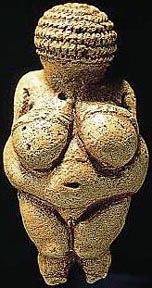
The famous Ice Age statuette known as Venus of Willendorf
and of Brassempouy show clear evidence of stylized hair.
Her head appears to be covered with what might be coils of braids.
Hair has, and will always, make a statement about how you see yourself, both internally and externally. Through the ages, styles have changed, but always seem to find their way back to natural long hair for woman, and functional styles for men. Styles vary with one's career, age, ethnic and racial backgrounds, genetic, health, among other factors. It seems that people want what they don't have in terms of hair texture. Color can be changed as can style. Look at yourself in the mirror and decided if you like your hairstyle and what is says about who you are today.
A hairstyle, hairdo, or haircut refers to the styling of hair, usually on the human scalp. The fashioning of hair can be considered an aspect of personal grooming, fashion, and cosmetics, although practical, cultural, and popular considerations also influence some hairstyles.
The remarkable head hair of humans has gained an important significance in nearly all present societies as well as any given historical period throughout the world. The haircut has always played a significant cultural and social role. Some of the earliest known works of art are statuettes of women, thousands of years old (the statuettes not the women), showing elaborate hairstyles. Hairstyles are both a display and can be a communication revealing social status and membership of a tribe or group.
Throughout history, people have worn their hair in a wide variety of styles, largely determined by the fashions of the culture they live in. Hairstyles are markers and signifiers of social class, age, marital status, racial identification, political beliefs and attitudes about gender.
In many cultures, often for religious reasons, women's hair is covered while in public, and in some, such as Haredi Judaism or European Orthodox communities, women's hair is shaved or cut very short, and covered with wigs. Only since the end of World War I have women begun to wear their hair short and in fairly natural styles.
In ancient civilizations, women's hair was often elaborately and carefully dressed in special ways. Women colored their hair, curled it, and pinned it up in a variety of ways. They set their hair in waves and curls using wet clay, which they dried in the sun and then combed out, or else by using a jelly made of quince seeds soaked in water, or curling tongs and curling irons of various kinds.

The famous Ice Age statuette known as Venus of Willendorf
and of Brassempouy show clear evidence of stylized hair.
Her head appears to be covered with what might be coils of braids.
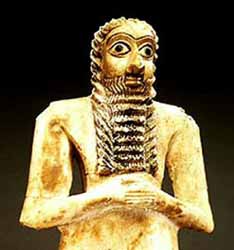


The Ancient Egyptians, known for their attention to beauty and cleanliness, used combs and hairpins in their tresses since about the 4th century B.C. Egyptian women believed thick hair was best and used hair extensions and wigs made of real hair or sheep's wool. They even dyed their hair and wigs a variety of colors, with blues, greens, blondes and golds being their favored choices. Wealthy Egyptians had personal barbers came to their homes.

In ancient Egypt head hair was often shaved, especially amongst children, as long hair was uncomfortable in the heat. Children were often left with a long lock of hair growing from one part of their heads, the practice being so common that it became the standard in Egyptian art for artists to depict children as always wearing this "sidelock". Many adult men and women kept their heads permanently shaved for comfort in the heat and to keep the head free of lice, while wearing a wig in public. In their graves we find combs and hairpins. They thought thick hair was best and used hair extensions and wigs made of real hair or sheep's wool. They dyed their hair and wigs a variety of colors with blues, greens, blondes and gold colors being among the preferred colors though black wigs hued by indigo were the favorite. Wealthy Egyptians had personal barbers who would come to their homes. They also used cosmetics and body oils. Women's wigs were often long and braided, adorned with gold ornaments or ivory hairpins. Men's faces were generally clean shaved, but stiff false beards were sometimes worn.
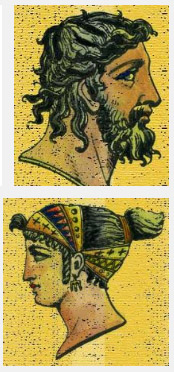
In ancient Greece men and women already differed from each other through their haircuts. The head hair of women was long and pulled back into a chignon. Many dyed their hair red with henna and sprinkled it with gold powder, often adorning it with fresh flowers. Men's hair was short and even occasionally shaved. Later, hairstyles became more ornate with hair curled tight and piled high on the head often shaped around wire frames. Hairdressing became popular and the upper classes were attended to by slaves or visited public barber shops.
In the ancient Minoan civilization the women wore their hair long with elaborately fashioned locks. This is probably because the women advertised their marital status with their locks. During the classical period women wore their hair long except when they were in mourning during which they cut their hair short. Slaves wore short hair. Before the 5th century women's hair was allowed to fall over the shoulders and back. It was often fastened by a headband or diadem. Later hair was often restrained. After the fifth Century BCE there were a number of possibilities including buns, headbands, scarfs, and hair covers. During hellenistic times the hair was artificially waved and curled.
Between 1500 and 650 B.C., Greek women wore their hair long and in corkscrew curls. Later, around 500-300 B.C., women began to wear their hair in what was termed "the Greek knot," which was basically a bun at the bottom of the neck. Soon, knots and buns were all the rage in Greece. It seemed that Greek women also had a penchant for highlighting their hair, which they did with saffron. The Greeks also developed a "calamistrum," which was a hollow bronze stick used to reshape their hair.
In ancient Rome hairdressing became ever more popular and the upper classes were attended to by slaves or visited public barber shops. Romans used false hairpieces to make their hair thicker or longer. Sometimes, Roman women wore their hair up, in carefully arranged styles, held with jeweled hairpins. Sometimes they wore it down, curled in ringlets. Fashionable women wore hair-pieces that were often made from the hair of slave girls.
Between 27 BC and 102 AD, in Imperial Rome, women wore their hair in complicated styles: a mass of curls on top, or in rows of waves, drawn back into ringlets or braids. Eventually noblewomen's hairstyles grew so complex that they required daily attention from several slaves and a stylist in order to be maintained. The hair was often lightened using wood ash, unslaked lime and sodium bicarbonate, or darkened with copper filings, oak-apples or leeches marinated in wine and vinegar. It was augmented by wigs, hairpieces and pads, and held in place by nets, pins, combs and pomade. Under the Byzantine Empire, noblewomen covered most of their hair with silk caps and pearl nets.
From the time of the Roman Empire until the Middle Ages, most women grew their hair as long as it would naturally grow. It was normally little styled by cutting, as women's hair was tied up on the head and covered on most occasions when outside the home with a snood, kerchief or veil; for an adult woman to wear uncovered and loose hair in the street was often restricted to prostitutes. Braiding and tying the hair was common. In the 16th century, women began to wear their hair in extremely ornate styles, often decorated with pearls, precious stones, ribbons and veils. Women used a technique called "lacing" or "taping," in which cords or ribbons were used to bind the hair around their heads.
During this period, most of the hair was braided and hidden under wimples, veils or couvrechefs. In the later half of the 15th century and on into the 16th century a very high hairline on the forehead was considered attractive, and wealthy women frequently plucked out hair at their temples and the napes of their necks, or used depilatory cream to remove it, if it would otherwise be visible at the edges of their hair coverings. Working-class women in this period wore their hair in simple styles.
During the 15th and 16th centuries, European men wore their hair cropped no longer than shoulder-length, with very fashionable men wearing bangs or fringes. In Italy it was common for men to dye their hair.
In the early 17th century male hairstyles grew longer, with waves or curls being considered desirable.
The male wig, was supposedly pioneered by King Louis XIII of France (1601-1643) in 1624 when he had prematurely begun to bald. This fashion was largely promoted by his son and successor Louis XIV of France (1638-1715) that contributed to its spread in European and European-influenced countries. The beard had been in a long decline and now disappeared among the upper classes.
Perukes or periwigs for men were introduced into the English-speaking world with other French styles when Charles II was restored to the throne in 1660, following a lengthy exile in France. These wigs were shoulder-length or longer, imitating the long hair that had become fashionable among men since the 1620s. Their use soon became popular in the English court. The London diarist Samuel Pepys recorded the day in 1665 that a barber had shaved his head and that he tried on his new periwig for the first time, but in a year of plague he was uneasy about wearing it.
Late 17th-century wigs were very long and wavy, but became shorter in the mid-18th century, by which time they were normally white (George II). A very common style had a single stiff curl running round the head at the end of the hair. By the late 18th-century the natural hair was often powdered to achieve the impression of a short wig, tied into a small tail or "queue" behind (George III).
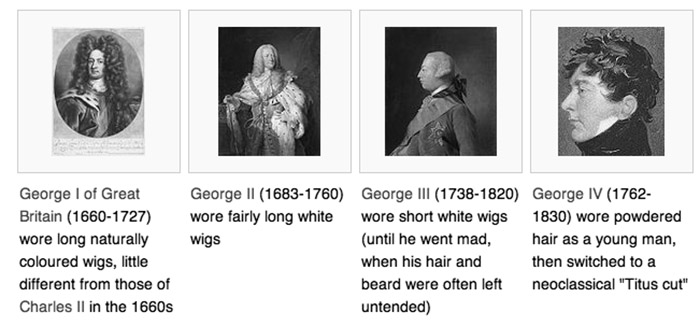
Short hair for fashionable men was a product of the Neoclassical movement. Classically inspired male hair styles included the Bedford Crop, arguably the precursor of most plain modern male styles, which was invented by the radical politician Francis Russell, 5th Duke of Bedford as a protest against a tax on hair powder; he encouraged his frends to adopt it by betting them they would not.
Another influential style (or group of styles) was named by the French after the Roman Emperor Titus, from his busts, with hair short and layered but somewhat piled up on the crown, often with restrained quiffs or locks hanging down; variants are familiar from the hair of both Napoleon and George IV of England. The style was supposed to have been introduced by the actor Franćois-Joseph Talma, who upstaged his wigged co-actors when appearing in productions of works such as Voltaire's Brutus. In 1799 a Parisian fashion magazine reported that even bald men were adopting Titus wigs, and the style was also worn by women, the Journal de Paris reporting in 1802 that "more than half of elegant women were wearing their hair or wig ą la Titus."
In the early 19th century the male beard, and also moustaches and sideburns, made a strong reappearance, associated with the Romantic movement, and all remained very common until the 1890s, after which younger men ceased to wear them, with World War I, when the majority of men in many countries saw military service, finally despatching the full beard except for older men retaining the styles of their youth, and those affecting a bohemian look. The short military-style mustache remained popular.
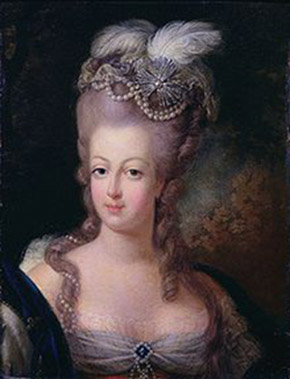
From the 16th to the 19th century, European women's hair became more visible while their hair coverings grew smaller, with both becoming more elaborate, and with hairstyles beginning to include ornamentation such as flowers, ostrich plumes, ropes of pearls, jewels, ribbons and small crafted objects such as replicas of ships and windmills.
Bound hair was felt to be symbolic of propriety: loosening one's hair was considered immodest and sexual, and sometimes was felt to have supernatural connotations.
Red hair was popular, particularly in England during the reign of the red-haired Elizabeth I, and women and aristocratic men used borax, saltpeter, saffron and sulfur powder to dye their hair red, making themselves nauseated and giving themselves headaches and nosebleeds.
During this period in Spain and Latin cultures, women wore lace mantillas, often worn over a high comb, and in Buenos Aires, there developed a fashion for extremely large tortoise-shell hair combs called peineton, which could measure up to three feet in height and width, and which are said by historians to have reflected the growing influence of France, rather than Spain, upon Argentinians.
In the middle of the 18th century the pouf style developed, with women creating volume in the hair at the front of the head, usually with a pad underneath to lift it higher, and ornamented the back with seashells, pearls or gemstones.
In 1750, women began dressing their hair with perfumed pomade and powdering it white. Just before World War I, some women began wearing silk turbans over their hair.
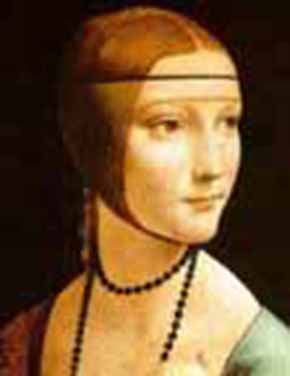
During the Medieval era, both men and women of the upper social classes wore their hair in loose curls. Women sometimes fastened gold balls at the end of their hair. The lower classes wore their hair undecorated and generally shorter, at the chin or shoulders. Noble women wore flat bonnets that covered their hair, or ribbons and gold threads in their hair. Later, bonnets, hats and veils became even more popular when church tradition decreed that married women were to keep their hair covered. Cone-shaped hats with a veil were also popular during this era. Women sometimes had their hair styled into what looked like two identical mounds on the both sides of the head.
During this time, a woman's high forehead was considered a beautiful feature, and women often shaved off their forehead to heighten their hairlines. Their foreheads were decorated with headbands which were sometimes adorned with pearls and stones. Women also wore nets in their hair during this era.
In the 15th century, The Renaissance Period, ladies of the upper classes tweezed the entire front hairline away to give the appearance of a higher forehead! The rest of the hair was tightly scraped back to show off the elaborate headdresses of the day. This was a practice common in Europe whereas the upper class ladies of Italy preferred to cover the hairline with low caps and jeweled turbans. They did, however, envy the fairer hair of Northern Europeans and sat for many hours in the heat of the sun in an attempt to Bleach their hair. The bleach of the day was made using either saffron or onion skins!
Also during the Renaissance, women again began to show their hair. Renaissance hairstyles essentially revived Roman and Greek hairstyles, and added more imagination.
Women decorated their hair with precious stones, pearls, ribbons and even shimmering veils. They also braided their hair, sometimes to form crowns around the tops of the heads. Again, hair was often dyed light colors such as blonde and gold. Some women used elements like alum, sulfur, soda, and rhubarb mixed together into a substance to dye their hair.
In France, ladies pulverized flowers into a powder and then used a gluey mixture to apply the powder into their hair.
Toward the end of the Renaissance, the general trend in fashion toward elaborate and whimsical styles extended to hairstyles. Women began wearing headdresses, at first a simple hood which then became peaked. Men wore broad hats that were sometimes trimmed with gemstones.
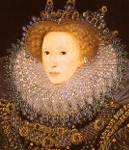
During the Elizabethan era, men and women wore very high collars, fashioned after Spanish couture. Men wore their hair short, while women combed their long hair upwards where it was fixed with a wire frame that formed a heart shape. By the 16th century Queen Elizabeth became the main female icon and set the trends for the era. Her lily-white complexion and red tresses set women everywhere rushing for copious amounts of white face powder and red wigs.
Women strove to imitate her curly red hair, using different recipes for bleaching their hair. Some of these recipes used strange elements, including urine. False hair and wigs were commonly used during this era, as they were easier to manage. Red wigs were especially popular during this era. Finally, elaborate headdresses entered the fashion scene during the Elizabethan period.
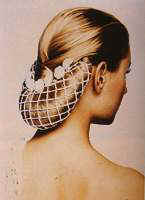
A headdress known as a snood was a type of hairnet that became highly popular. Similar headdresses appeared, such as a bag-coif which featured a gathered bag at the back covering the wearer's head. The fabric of the bag could match the dress, or could be made of a plain black silk, covered with gold netting.
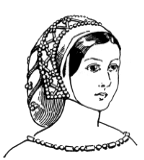
In Italy, a fashionable early 16th century headdress known as the balzo was similar to a snood. It was a large gathered bag, often made of woven strips of fabric, fancy gold material and lace, or other materials, worn over the hair. From the front, it looked more like a roll worn over the hair, as the greater portion of its bulk was above the head.
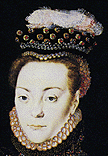
In period portraits, cauls were made of fabric, or fabric covered by netted cord. Cauls were also frequently decorated with applied cord, couched or embroidered on, as well as pearls, gems, and other expensive decoration for the nobility.

The 18th century saw the emergence of elaborate wigs, mile-high coiffures and highly decorated curls. White powdered wigs with long ringlets were the order of the day often tied back with a black bow for men or decorated with feathers, bows and garlands for women. Big hair was definitely stylishand many hairdos were modeled over a cage frame or horsehair pads, the bigger the better. Some immensely tall coiffures took hours to create and were heavily starched and powdered. However, the length of time spent creating these elaborate styles did mean that weeks went by between styling and the mixture of horsehair and heavy powder created perfect nesting material for vermin. This didn't seem to put them off though, and some adventurous souls had mini gardens or maritime scenes complete with model ship incorporated into their style – in fact it was not unknown for imaginative ladies to create mini-bird cages complete with birds on top of their heads.
Baroque women parted their hair down the middle, often using a cross or a round parting in their hair. They also had curls that trimmed their foreheads and fell like ringlets down the sides of the face. Sometimes these ringlets were quite thick.
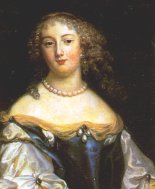
During the same time, another fashion trend emerged called an hurluberlu coiffure. This style required that the hair be worn short, in a mop of downward-pointing curls which were arranged thickly at the back of the head and neck.
In the 18th century, wigs, specifically powdered wigs were in fashion. Both men and women wore them, especially the upper classes and royalty. These wigs were usually powdered white
During this era began to grow out their hair. Curly hair, mustaches and goatees were all the rage during this era.
Louis the 13th, (who reportedly became bald quite early on) had a curly wig made. During this era, wigs were made of either human or horse hair. In the 17th and 18th centuries, wigs became something of a status symbol and the more wigs one had, the more prestigious or wealthy one was considered.
Later in this era, the soft natural styles were replaced by more formal, stiff styles. By the end of the Baroque era, women began sweeping their hair into such tall fashions that some reached 60 centimeters in height!
By the early 1800s, the powdered wigs of the Georgian era were forever relegated from fashion, as men of the period began wearing their hair short and natural.
During the Regency era, women's clothing as well as hairstyles were modeled after Greek and Roman styles. Women wore their hair up and fastened their buns with ornamental combs, diadems, bonnets and silk ribbons. They parted their hair in the shape of T, V, Y and U's. Regency girls often curled their hair at the front to crown their faces with soft ringlets. Ladies also wore bonnets, hats or turbans.
Following the decadence of the previous era, the Victorians took a much more subdued and puritanical line. Middleclass ladies, although not abandoning make-up completely, did tone things down considerably with more of an emphasis on natural beauty. A Victorian lady would play up her natural features and aimed at a healthy hygienic look. Hair was supposed to look sleek, shiny and healthy and styles were altogether more elegant and demure. The hair was often smoothed down with oils and curled into long ringlets, fringes were short and decoration was more subtle. Hairnets were often worn during the day to keep curls confined and clipped to the back of the head with a simple ivory comb or black bow. Later in the century hair was often plaited and wound into heavy coils pinned neatly to the nape of the neck. Neatness was the order of the day and loose hair would have been considered vulgar. Men of the time kept their hair relatively short, pomaded with macassar oil and most would have worn some form of moustache, beard and sideburns.
During the Victorian era, having one's hair styled by a hairdresser became popular. French hairstyles that were parted in the middle became trendy, while adorning one's head with flowers also gained stead.
Austrian empress Elizabeth was the first to place flowers in her hair, and she soon started a widespread trend.
Barley curls or sugar curls were long drop curls worn by children throughout the century.
In the early 1840's, women took to wearing these curls alongside a coiled chignon, which was situated at the back of the head. Women continued to wear hats during this era.
Fine milliners created fanciful styles decorated with plumes and ribbons.
During the 1870's, the hair at the back of the head was occasionally allowed to hang loose, long and full, a lovely natural look that was featured in many pre-Raphaelite portraits. Sometimes the hair was seen in ringlets, and sometimes in large loops.
In 1872, an important invention in hairstyling was invented: crimping. Crimping allowed for a "turned up hairstyle" in which the hair was pulled over a hot iron, resulting in an attractive wave.
The "Marcel wave" was a new style created by the hot iron, and consisted of loose waves arranged around the head.
By the end of the 1880's, pompadours were worn. This was a style in which the hair was swept up high from the forehead. Often, fake hair pieces were used to add height and depth. In addition, the "titus" hairstyle became popular from the 1880s. This hairstyle involved cutting the hair very close around the head. The hair was then curled, and styled with various ornaments including flowers.
By the Gay Nineties, high hairstyles had almost disappeared from the landscape of fashion trends.
The look of the Gibson Girl was much more natural. A bun swept loosely on the head became the crowning feature of young Victorian girls. The psyche knot was especially prominent. This was basically hair pulled back from the forehead and knotted on the top of the head. Small coiffures, pompadours, and French twists were also worn, along with hair ornaments.
Amongst the Muslim community the hair was traditionally concealed in public. Men wore a turban or fez and womens hair was hidden under the traditional veil. Both men and women visited the local public baths for grooming where the mans head and face were shaved and omens long hair was given a henna rinse.
Due to the many tribal customs African hairstyles were many and varied and usually signified status. Masai warriors tied the front hair into sections of tiny braids whilst the back hair was allowed to grow to waist length. Non-warriors and women, however shaved their heads. Many tribes dyed the hair with red earth and grease - some even stiffened it with animal dung. The complex style of the Mangbetu women involved plaiting the hair thinly and arranging over a cone-shaped basket frame, flaring the top then adorning the whole thing with long, bone needles. Other tribes such as the Miango took amore simple approach, covering their long ponytails with a headscarf and adorning with leaves.
The traditional hair styling in some parts of Africa also gives interesting examples of how people dealt with their head hair. The Maasai warriors tied the front hair into sections of tiny braids while the back hair was allowed to grow to waist length. Women and non-warriors, however, shaved their heads. Many tribes dyed the hair with red earth and grease; some stiffened it with animal dung.
Among the Temne People of Africa, it took hours or days to fashion a hairstyle. The fine rows of the hairstyle were a symbolic representation of the cultivation of the land and thus indicated civilization.
In Israel and other parts of the Middle East, women often kept their hair covered by fabric draped about the face like a hood. Hairstyles in the Middle East and elsewhere, in fact held deeper significance. Some cultures considered women's long hair to be provocative that it had to be covered up or controlled in tight braids, rolls or curls.
The prophet Samson's power was recorded in Scripture as being innately connected to his long, thick hair.

Hair and nails became part of magic in Persia. The use of small figures of wax or other plastic-like materials fashioned with incantations in the likeness of some enemy and then pierced with nails and pins, or melted before the fire, that their human counterpart may by these means be made to suffer all kinds of torment is known to have been prevalent among Semetic peoples. It was considered more effective to obtain some portion of the victim's nails or hair, as an additional connection whereby the wax figures may be brought into still closer affinity with its prototype. It has been supposed that injunctions contained in the Vendidad of the Iranians to bury nails and hair to avoid future calamities was due to the prevalence of similar customs among them. Enemies of the Persian Prophet Zarthustra accused him of sorcery by secretly placing hair, nails and such other impurities in his room and resulting in his brief imprisoned, a form of magic.
In China unmarried girls' hair was usually worn long and braided while women combed the hair back from the face and wound into a knot at the nape. The Manchu regime of the time dictated that men shaved the front of the head and wore the back hair long and braided, tied with black silk.
Males in Japan also shaved the front of the head but kept the back hair pulled tightly into a short stiff ponytail. During the Medieval period women's hair had been long and loose but by the 17th century the hair became more styled, swept up from the nape of the neck and adorned with pins and jeweled combs.
Geisha women's hairdos were especially elaborate, high and heavily lacquered and often enhanced with hairpieces.
In the early 1870s, in a shift that historians attribute to the influence of the West, Japanese men began cutting their hair into styles known as jangiri or zangiri (which roughly means "random cropping"). During this period, Asian women were still wearing traditional hairstyles held up with combs, pins and sticks crafted from tortoise, metal, wood and other materials, but in the middle 1880s, upper-class Japanese women began pushing back their hair in the Western style (known as sokuhatsu), or adopting Westernized versions of traditional Japanese hairstyles (these were called yakaimaki, or literally, soirée chignon).
These hairstyles are termed 'cornrows.' Among the Polynesians of the Pacific, the first time a boy's hair was cut marked his coming of age. It was also a way in which he was now differentiated from women. Hair was thought to contain the mana or power, and so the cutting of hair was a risky business. To mark this special occasion, the women of the Cook Islands draped tivaevae, specially decorated quilts, about the room. These tivaevae were given as gifts to mark special occasions such as this haircutting ceremony.
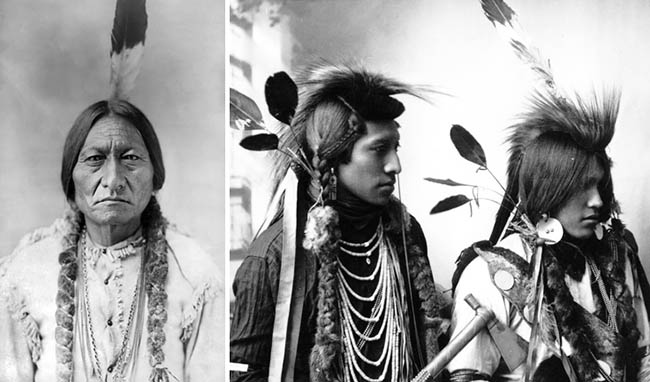

Native Americans were divided in their hairstyles - those on the East Coast sporting entirely shaved heads save for a ridge of hair along the crown, whilst Plains Indians, both men and women, wore the recognized long braids adorned with feathers.
Aztecs -- Mature, married Aztec women typically wore their hair in two horn-like tufts while younger women often wore it straight and long sometimes down to the waist.
The Inca sported black headbands over relatively, short often bobbed hair, while Aztec women plaited their hair entwined with strips of coloured cloth then wound around the head.
The Mayan nobility, although having shaved heads, donned high, ornate headdresses.
1920's society very much abandoned the puritanical standards and constraints of Victorian life. The Roaring Twenties saw the emergence of short, bobbed and waved styles, signifying the new independent, free-spirited, free-woman ethos of the day. Women increasingly had access to cinema and theater and trends were set by the 'superstars' of the time. Make-up was very much back in fashion - powder, rouge and very red lips were 'in' albeit in a more demure way than the earlier 18th century Style.
Men's hair remained short, as in the Victorian era but was most often worn with a center parting and slicked back using brilliantine and highly perfumed oils.
During the First World War, women around the world started to shift to shorter hairstyles that were easier to manage. In the 1920s women started for the first time to bob, shingle and crop their hair, often covering it with small head-hugging cloche hats. In Korea, the bob was called tanbal.
Women began marceling their hair, creating deep waves in it using heated scissor irons. Durable permanent waving became popular also in this period: it was an expensive, uncomfortable and time-consuming process, in which the hair was put in curlers and inserted into a steam or dry heat machine.
During the 1930s women began to wear their hair slightly longer, in pageboys, bobs or waves and curls.
During this period, Western men began to wear their hair in ways popularized by movie stars such as Douglas Fairbanks, Jr. and Rudolph Valentino. Men wore their hair short, and either parted on the side or in the middle, or combed straight back, and used pomade, creams and tonics to keep their hair in place. At the beginning of the Second World War and for some time afterwards, men's haircuts grew shorter, mimicking the military crewcut.
During the 1920s and 1930s, Japanese women began wearing their hair in a style called mimi-kakushi (literally, "ear hiding"), in which hair was pulled back to cover the ears and tied into a bun at the nape of the neck. Waved or curled hair became increasingly popular for Japanese women throughout this period, and permanent waves, though controversial, were extremely popular. Bobbed hair also became more popular for Japanese women, mainly among actresses and moga, or "cut-hair girls," young Japanese women who followed Westernized fashions and lifestyles in the 1920s.
In the 1940s women continued to follow their on-screen idols, with the emphasis on feminine, romantic styles. Soft curls falling onto the shoulders or long, wavy natural looks were popular and for the first time sun-tans became popular - probably inspired by Hollywood starlets. Of course these styles would have been saved for evening wear - as the war years raged something of a more practical nature was needed. Many women worked either on the land or in the munitions factories, and as shampoo and non-essential items were hard to come by fashion was often dictated by practicality. Practical women wore their hair in a neat roll around the nape and over the ears, often covered with a headscarf knottedat the front leaving only the fringe exposed. Plastic hair rollers were an essential part of styling as was styling lotion to hold the hair in place for as long as possible.
By the 1950's, with the constraints of war at an end, glamour became popular and women attempted to achieve a look what implied domestic goddess. The impression that all household chores could be accomplished whilst still looking stylish and well groomed was aspired to. Returning to the home duties after the demands of war-time meant women could spend more time on achieving the '50's ideal of beauty. Eyebrows, mascara and eyeliner became heavier with intense coloured lips highlighting a pale complexion. Hair began to suffer abuse however and was teased, sculpted, sprayed, permanently waved and forced into perfectly formed curls. Hair often resembled a perfecthelmet and women started to visit salons on a weekly basis for he shampoo and set. Men of the day were also prepared to spend time copying their idols James Dean and Elvis and greased back hairdo's were coupled with long, heavy sideburns.
In the 1960s, many women began to wear their hair in short modern cuts such as the pixie cut, while in the 1970s, hair tended to be longer and looser. In both the 1960s and 1970s many men and women wore their hair very long and straight.
Complex hair styles were definitely out in the 1960's. Women were once again moving into the workplace and needed to adopt a more achievable style for a day-time look. Many favored short, back-combed hairstyles that could be quickly styled and held in place with hair spray, softened with a long, feminine fringe. Younger women who left their hair longer tended to wear it loose or in a simple ponytail, adorning it with flowers or ribbons during the fashionable hippy phase. Both hair and make-up was kept simple, the emphasis being on natural, healthy looks - the all American girl-next-door look was widely popular. Blonde was the color to be and darker hair was often given highlights and the sun-kissed look by soaking strands of hair in lemon juice and sitting in the sun.
Women straightened their hair through chemical straightening processes, by ironing their hair at home with a clothes iron, or by rolling it up with large empty cans while wet.
> African-American men and women began wearing their hair naturally (unprocessed) in large Afros, sometimes ornamented with Afro picks made from wood or plastic. By the end of the 1970s the Afro had fallen out of favor among African-Americans, and was being replaced by other natural hairstyles such as cane rows and dreadlocks.
Since the 1970s, women have worn their hair in a wide variety of fairly natural styles. In the nineteen-eighties women pulled back their hair with scrunchies, stretchy ponytail holders made from cloth over fabric bands. Women also often wear glittery ornaments today, as well as claw-style barrettes used to secure ponytails and other upswept or partially upswept hairstyles.
Today, women and men can choose from a broad range of hairstyles, but they are still expected to wear their hair in ways that conform to gender norms: in much of the world, men with long hair and women whose hair doesn't appear carefully groomed may face various forms of discrimination, including harassment, social shaming or workplace discrimination. This is somewhat less true of African-American men, who wear their hair in a variety of styles that overlap with those of African-American women, including braids and cornrows fastened with rubber bands and dreadlocks.
Long, free and natural best describes hair in the 1970's. Manes of free-falling curls, soft partings and long fringes were complemented by bronzed skin and glossy lips, soft tailored clothes and the ultimate aim was soft, feminine and romantic. The cult-series 'Charlies Angels' depicted everything that 70's woman should be. Even male styling became softer with 'feathered' cuts, highlights and soft layers. Use of products was limited as the aim was natural looking hair and products were marketed accordingly with an increase in the use of plant and herb extracts. Towards the end of the era though, certain sections rebelled against this floral, romantic image and the distinctive if somewhat shocking looks of the Punk briefly pre-vailed. Spiked hair, dyed vivid primary or fluorescent colours, tattooed scalps or outrageous Mohicans graced the high streets.
The Age of Excess, otherwise known as the 1980's saw less constraints and more freedom of choice in styles and trends. People were no longer prepared to conform to a set image and many variances occurred. On the one hand were the 'power dressers' - immaculate women with strong tailored clothes and meticulously groomed hairstyles. The long-bob was highly favored-precisely cut and evenly curled under, a good hairdresser was an essential part of this woman's life. This woman's hairstyle reflected control, a busy work life, a hectic social life but on top of it all even her hair style. The rebellious element on the other hand were busy following Madonna's ever-changing style and were willing to sport unconventional, choppy off-colored hairdo's, to match their unconventional, eccentric clothing.
During the 1990's hair and beauty styles were constantly changing and pretty much anything was acceptable. A huge fad was the Rachel cut, Jennifer Aniston's character in 'Friends' hair was long and sleek with longer length layers, a grown-out fringe and framed with highlights around the face. Also extremely popular were short, choppy styles as Meg Ryan's and many variations on the same theme. Messed-up hair was very much in but whether long or short it seemed the whole world had definitely gone blonde! Multi-toned highlights, all over blonde - any shade of blonde in fact, even previously brunette models and film stars turned blonde. With golden tresses and full, pouty glossy lips and sultry eyes the look was definitely a throwback to the Bridget Bardot 'Sex Kitten' style.
Men on the other hand were very minimalist in their approach - shaved heads being the order of the day. In fact anything over an inch was deemed long and there was a new trend for products. Prior to the nineties men had made do with shampoo alone, or occasionally pinched the girlfriends hair gel but the 'new man' image encouraged companies to produce all kinds of new products for men. With new all-male packaging of men's toiletries it became completely acceptable for men's bathrooms to sport as many products as females.
A hairstyle's aesthetic considerations may be determined by many factors, such as the subject's physical attributes and desired self-image or the stylist's artistic instincts.
Physical factors include natural hair type and growth patterns, face and head shape from various angles, and overall body proportions; medical considerations may also apply. Self-image may be directed toward conforming to mainstream values (military-style crew cuts or current "fad" hairstyles such as the Dido flip), identifying with distinctively groomed subgroups (e.g., punk hair), or obeying religious dictates (e.g., Orthodox Jewish have payot, Rastafari have Dreadlocks, North India jatas, or the Sikh practice of Kesh), though this is highly contextual and a "mainstream" look in one setting may be limited to a "subgroup" in another.
A hairstyle is achieved by arranging hair in a certain way, occasionally using combs, a blow-dryer, gel, or other products. The practice of styling hair is often called hairdressing, especially when done as an occupation.
Hairstyling may also include adding accessories (such as headbands or barrettes) to the hair to hold it in place, enhance its ornamental appearance, or partially or fully conceal it with coverings such as a kippa, hijab, tam or turban.
2014: Women wear extensions for a long sultry look. Met with hair loss, often shave their heads. Gone is the look of men with long hair unless performers.